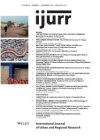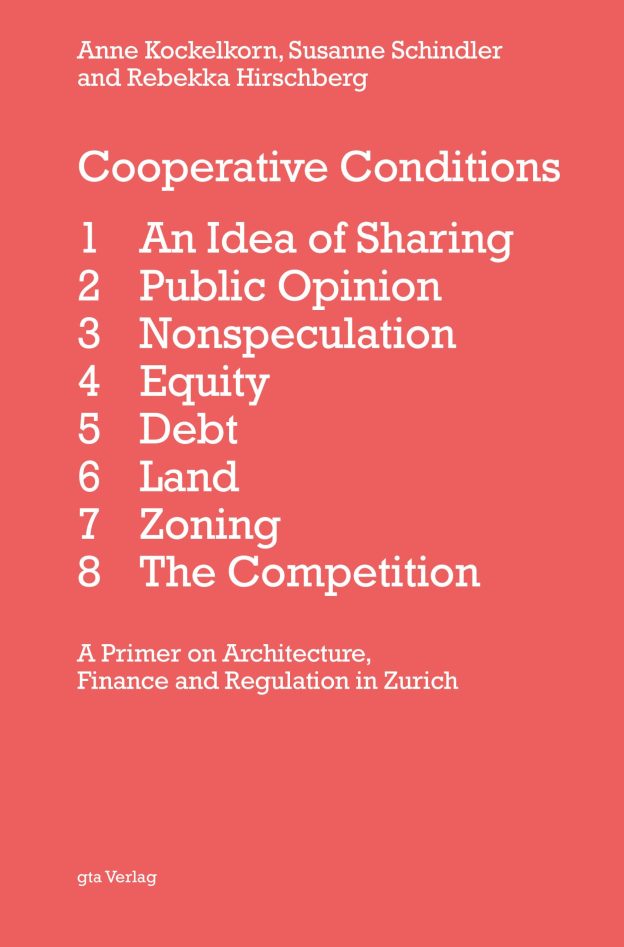How can it be that Zurich, a centre of global finance and a city deeply entangled in real estate financialization, has a thriving sector of relatively decommodified housing cooperatives? This, Cooperative Conditions argues, is due to the long history of Gemeinnützigkeit as a principle in the city’s housing policy. Literally meaning ‘common utility’ and often translated as ‘nonprofit’, the German term is retained by the authors to emphasize that, rather than being only about profit, Gemeinnützigkeit involves a commitment to nonspeculation and public value. This leads them to treat Zurich’s cooperatives as urban commons.
Cooperative Conditions in this way addresses several key concerns among many scholars, activists and practitioners. But the book will be particularly interesting for those engaging with alternative housing forms in general and housing cooperatives in particular. While developed from a history and theory of architecture course, which is reflected in the naming of additional contributors to all chapters, the book is not limited to readers in and around the field of architecture. Rather, it aims to enhance the ‘economic literacy’ of architects and the ‘spatial literacy’ of non-architects.
Zurich’s Gemeinnützigkeit cooperatives own their estates collectively and, through the purchase of a cost-based share, members get the use right to a dwelling for which they pay rent. This setup necessitates members having some means, but the cost of access and rent is considerably lower than it would be on the private market. These cooperatives today account for some 18% of Zurich’s housing and there are more than 140 cooperative organizations, some large and with long histories, others small and recent. For the cooperatives, the benefits of Gemeinnützigkeit are favourable loans and the possibility of leasing municipality-owned land. In return, the city gets affordable housing and wider public value, notably in the shape of innovative architecture and more inclusive urbanism.
Framed by an informative introduction and a punchy conclusion, the book is divided into eight chapters, each addressing an interconnected condition for the Zurich model of housing cooperatives: (1) ‘An idea of sharing’—outlining the model’s basis in the sharing of resources, property and governance; (2) ‘Public opinion’—on how cooperatives depend on broader public support (but not subsidies); (3) ‘Nonspeculation’ as the key premise; (4) ‘Equity’ and (5) ‘Debt’ engaging with the financial constructs; (6) ‘Land’ and (7) ‘Zoning’ addressing access to land; and (8) ‘The competition’—on how the application of Gemeinnützigkeit requires architectural competitions that facilitate projects’ public value.
The instruments of these conditions are addressed in chapter prefaces. ‘Instruments’ here refers to legal and societal frameworks of norms, rules, laws, contracts, conventions and other institutions shaping urban development. Following from this, and sounding more complex than it actually is to read, the conditions are analysed as interplays between the agency of human actors, regulatory constructs (the ‘instruments’) and the built environment. It is here that the authors’ desire to bring a distinctly architectural perspective to debates on housing alternatives is most pronounced.
The findings are summarized in seven key takeaways. First, the Zurich model shows that market rate is not a natural condition; above average quality housing can be priced at what it costs to produce and operate. Second, while their land and buildings cannot be sold, the decommodified cooperatives can, somewhat paradoxically, benefit from the market, as they can borrow against the theoretical market value. Third, the maintenance of nonspeculation requires broader institutional frameworks; the autonomy of the cooperatives is ‘circumscribed’ and this ‘refutes the idea of the autonomous collective’ (p. 291). Fourth, the institutional framework comprising state, market and cooperative sector is premised on a level of trust, which, the authors find, will grow only in specific circumstances. Fifth, the stability of the model requires ongoing transformation, and this is possible only because cooperatives do not have to achieve an immediate financial return. Sixth, since the cooperatives have a long-term perspective, they are pioneers of architecture and urbanization—and safe investments for the municipality and banks. Finally, the Zurich cooperatives’ architectural and urbanistic achievements are enabled because, rather than in spite, of their commitment to Gemeinnützigkeit. This, the authors conclude, demonstrates the cooperatives’ public value and ‘the agency of nonspeculation’ (p. 293).
As one would expect from a book originating in the field of architecture, Cooperative Conditions is richly equipped with illustrative photos, plans and historical images. This makes it a very enjoyable read. I find the ‘instruments’ sections particularly valuable, as they—supported by illuminating figures—give concise presentations of the mechanics of Zurich housing cooperatives. Together, these sections read as outlines to a political economy of the Zurich model.
With good reason, the authors are impressed by the Zurich model, and the book predominantly focuses on its notable achievements. Owing maybe to its constructive aim to be a ‘primer’, possible shadows are not pursued. One of them, as the authors note in passing, is that while cooperatives may be affordable, their relative autonomy could limit accessibility along non-economic lines. Such dimensions of cooperativism should also be investigated, but I recognize that this is not the aim of the book.
Cooperative Conditions vividly portrays what (leaning on Matthias Bernt) could be termed a cooperative commodification gap. The beauty of the Zurich model is precisely that it produces urban spaces with notable disparities between the partly decommodified current ground rent and the potential market ground rent. This facilitates affordability and other public value, but is premised on the involved actors’ continued commitment to Gemeinnützigkeit. Unfortunately, as we know from other contexts, the (local) state’s often crucial role in engendering and maintaining relatively decommodified cooperatives is not a given. While it is beyond the remits of the book to address this problem, it points to the importance of studying the political economy of alternative housing forms, not only to learn from their strengths but also to identify their weaknesses.
At a time when partly self-imposed norms lead to our churning out often empirically shallow articles, Cooperative Conditions is a highly welcome contribution. It should be widely read, and will, I hope, inspire others to pursue similarly rich, engaged and accessible studies of housing alternatives.
Henrik Gutzon Larsen, Lund University
Anne Kockelkorn, Susanne Schindler and Rebekka Hirschberg 2024: Cooperative conditions: a primer on architecture, finance and regulation in Zurich. Zurich: gta Verlag
Views expressed in this section are independent and do not represent the opinion of the editors.

